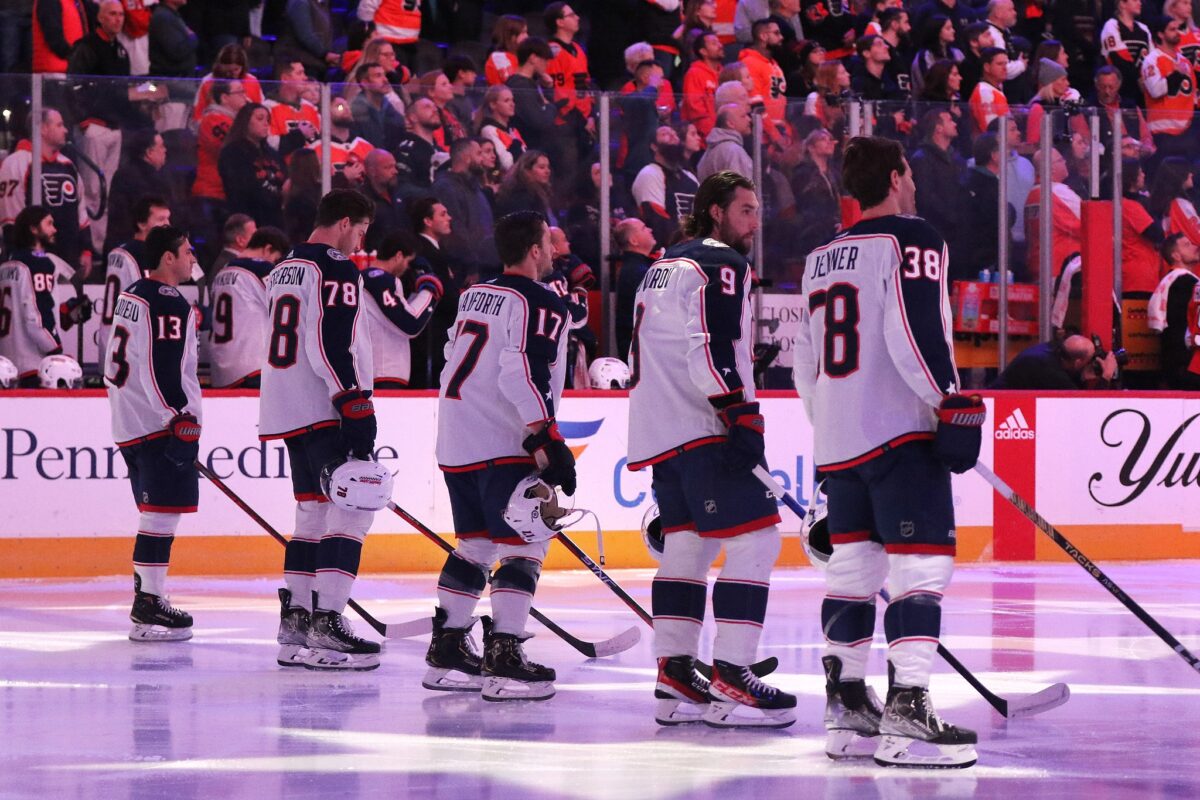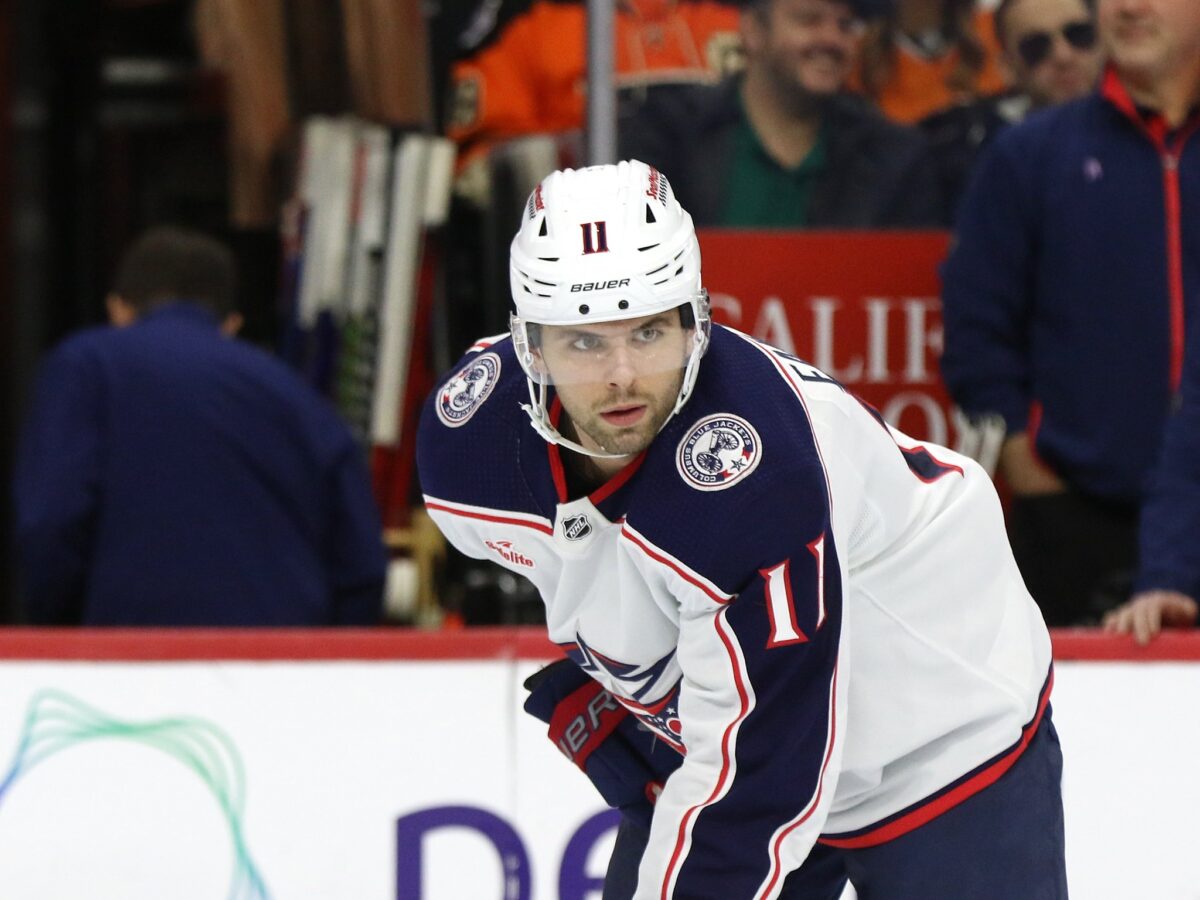It is a question that the Columbus Blue Jackets have surely tried to tackle in the past. As this 2023-24 season winds down, it will once again be a question they must face head on.
This time though, the team must take a hard look in the mirror and find solutions to this ever-present problem. What do they make of all the injuries? Is it really just continuous bad luck? Or is there a deeper issue at hand?
Entering Sunday afternoon’s game against the Carolina Hurricanes, the Blue Jackets reported having 286 man-games lost to injury. Most of that accumulated in the second half of the season. In case you need a refresher, here is the current list of injuries and absences the team is facing.
- Patrik Laine (currently in the Player Assistance Program)
- Adam Fantilli (lacerated calf)
- Kent Johnson (shoulder injury)
- Yegor Chinakhov (upper-body injury)
- Sean Kuraly (lower-body injury)
- Adam Boqvist (upper-body injury)
- Elvis Merzlikins (lower-body injury)
- Jake Bean (broken hand)
- Daniil Tarasov (upper-body injury)
As you can see, injuries have ravaged this team once again. The number of man-games lost isn’t as bad as it was last season. However it will eclipse 300 games by the end of the season. That means the Blue Jackets have lost over 800 man-games to injuries since the start of the 2022 season.
I have a few theories on this. Ultimately, the Blue Jackets have to decide what if any changes need to be made. While there is definitely an element of bad luck involved, there are things they can do better as well. Let’s dive in.
Injuries Are Like Stock Market
Let’s start with a comparison. In one sense, injuries are like the stock market. Anyone who invests in the stock market knows that investing is risky. While they can certainly gain money, they can also lose it just as easily.
In the stock market, there are certain factors investors can control. For example, they can diversify their portfolio. They can choose how and where to invest. But no matter how an investor acts, there is no perfect solution. In other words, they can limit their risk but they can’t completely eliminate risk.

Then there are factors outside of the investor’s control. Market conditions, decisions by the federal reserve and other outside factors are assumed risk when investing. Are you starting to see the picture here?
Injuries are a lot like the stock market. A player can control certain aspects such as their training, their food intake, their warmup routine such as stretching and how much time they put into these things. But no matter how they train, just by simply playing the game, they run the risk of injury.
Not All Injuries Are Equal
Now that we see just being on the ice brings an injury risk at anytime, we need to look at specific injuries and what may have led to them. There are different classifications of injuries that must be considered.
First are accidental injuries. These are injuries that happen throughout the course of the game where there was no intent to injure but for one reason or another, it happened. Take Fantilli’s calf laceration for example. An opposing player’s skate stepped on his calf. That’s an accident. Accidents happen all over the place and take on different forms.
Other accidents include deflected pucks in the face and being high-sticked among other things. Boone Jenner suffered a broken jaw in this manner. There was nothing he could do. He was in the wrong place at the wrong time when the deflection took place. That’s brutal luck. That happens in hockey.
Now we need to discuss the other kinds of injuries. There are times when an opponent targets a player and injures them. Laine taking a head shot from Rasmus Andersson fits in this category. But then there are injuries that could have been prevented. Cramping comes to mind. That could potentially point to other issues of why the cramping occurred. Certain muscle injuries could have also been prevented as well.
Injuries come in all shapes and sizes and can be accidental or more targeted. Now we need to consider why injuries affect certain teams more than others? If this was all that was involved, you’d expect to see more uniform numbers across the league.
Possible Reasons for Injury Disparity
This is the area where the Blue Jackets need to do a full-scale review of how they’re running things. Over 800 man-games lost in two seasons require a full review from top-to-bottom.
Back to the stock-market comparison for a moment. We said investors can control certain things to limit their risk. Teams can control certain things to limit their risk as well.
For example, teams that do not have the puck much put themselves at more risk of having to block shots. The more shots a team blocks, the more risk there is for an injury since there is more opportunity for pucks to injure a player.
This points to a team’s playing style as a potential area that needs reviewed. How a team plays could open them up for more risk of injury. Again there is nothing a team can do to completely eliminate risk. But they can take steps to limit their risk. If a team plays a style that depends on more puck possession rather than constantly blocking shots, they limit their risk on a shot block or deflection creating an injury.
You May Also Like
- Jakub Voracek Announces Retirement From the NHL
- Blue Jackets Need Major Shake Up For Sake of Winning
- 17 Blue Jackets’ Thoughts From End of Season Media Day
- First NHL Shot, First NHL Goal for Blue Jackets’ Del Bel Belluz
- Projected Lineups for the Hurricanes vs Blue Jackets – 4/16/24
At the player level, an individual player can make choices that can help limit their risk for injury. Do they try to make big hits all the time? Perhaps they can be more selective on what hits to pursue.
Awareness is also a key element. If a player has their head down, they could open themselves up for a huge hit that creates an injury. Awareness and being in the right places can lead to decreased risk for injury.
Then there’s also the concept of pain and injury tolerance. Some players can play through certain injuries and others are not at the same level. That will factor in to what the injury numbers look like. Man-games lost is just that. It’s the number of games not played due to injury. The players who play through an injury are not factored into those counts.
Recovery and Reinjury
Whether it leads to meaningful changes or not, this is another area the Blue Jackets have to evaluate. Are they experiencing good outcomes in recovery? Are they seeing re-injury? Are they seeing patterns in injuries?
Whatever the exact reasoning is, it’s important to note that Fantilli’s recovery has been slower than expected. Coach Pascal Vincent admitted that last week. The team will need to evaluate this and determine if this could have been handled better.

The Blue Jackets will also need to look at players injured more than once. Boqvist and Merzlikins come to mind. Are there areas within those situations they can improve on?
Then there are some of the patterns in injuries. Johnson had the same shoulder surgery as Werenski did. Why all of these shoulder injuries? Josh Anderson had it too. So did Justin Danforth. Four players with the same major injury? Hmmm.
In Conclusion
As you can see, several possible reasons exist which should cause the Blue Jackets to look at things at the micro level. One of the most important things the new general manager will have to determine is what to make of all these injuries and what if any changes they can make to see improved results. Losing that many man games to injury points to opportunity for improvement.
In the end, the Blue Jackets have had awful injury luck with several situations out of their control. But at the same time, they also have an opportunity to make key changes to help reduce their risk for future injury.
If the Blue Jackets want to get this trending back in the right direction, it’s going to take everyone to make it happen. Players need to evaluate their daily habits and make necessary changes so they’re in the best position to limit their risk. The staff needs to ensure everything from training programs, nutrition and recovery methods are the most effective to meet the needs of the players. Management needs to ensure the proper people are staffed in order for all these things to work effectively together.
The best teams in the NHL consistently are able to keep their man-games lost number down. The Blue Jackets have a lot of work to do in that area. We’ll see throughout this offseason how the team views this and what changes they make. The one thing we do know is something, perhaps many somethings, need to change.
